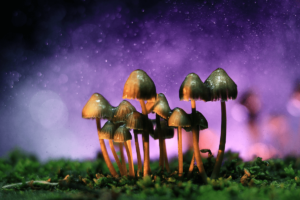As cannabis’s medicinal properties have entered the public consciousness, we’ve become more aware of alternative (and sometimes controversial) treatments that can have a profound impact on hard-to-treat conditions. The problem with these treatments, however, is that little scientific research exists to support their use. Enter MAPS, the Multidisciplinary Association for Psychedelic Studies.
Since 1986, MAPS has helped fund and organize research on the medicinal uses of psychedelics and cannabis. Some of its current work involves finding alternative treatments to post-traumatic stress disorder (PTSD), a common condition that’s known for being hard to treat.
FOLLOW US ON FACEBOOK & INSTAGRAM
PTSD affects more than 13 million people at any given time, and in some cases, it can be life threatening: Research shows that suicide risk is greater among people with this disorder.
With this in mind, you’d think that we’d have effective methods of treating PTSD. But we don’t—at least not yet.
MAPS recently finished a series of phase two, double-blind clinical trials on the use of 3,4-methylenedioxy-methamphetamine (MDMA) during psychotherapy sessions for folks with PTSD—and the results were good. So good in fact, that the Federal Drug Administration (FDA) is now working closely with MAPS on the design of its phase three research on the topic.
“Based on those preliminary results, [the FDA] thinks that it’s a treatment that could be a potentially significant advance over what’s currently available for PTSD,” says Brad Burge, director of strategic communications at MAPS.
What Is MDMA?
MDMA was first created in a lab in 1912. In the 1970s, it was used to improve psychotherapy sessions, and by the 1980s it had become a popular recreational drug associated with dance parties and raves. MDMA purchased on the street is often cut with other drugs and is commonly referred to as molly or ecstasy.
In 1985, the U.S. Drug Enforcement Administration made MDMA a schedule I substance, labeling it as an illegal drug with no medicinal value. This archaic designation remains today, much in the same way as it does with cannabis. And similar to cannabis, we’re now realizing that MDMA has therapeutic potential.
MDMA Increases the Amount of Serotonin & Dopamine in the Brain
“MDMA—I like to think of it as a chemical security blanket,” says Brad. He says that MDMA allows people to “feel safer and more comfortable and confident in themselves and in their connections and relationships.”
He adds that MDMA lets people feel this way while talking about difficult, painful experiences. And it enables them to process difficult feelings in a new way.
But what’s going on in the brain that allows this to happen? We have some research, but much more is needed.
Brad says that the FDA doesn’t need to know exactly how a treatment works in order to get it approved. It only needs to know that the treatment is effective and that the benefits outweigh the risks. “Which is kind of crazy when you think of all the things that they approve,” he adds.
With a combination of research and some conjecture, here’s what Brad and his colleagues think is going on: MDMA prompts the release of dopamine and serotonin in the brain, while also toning down activity in the amygdala.
Serotonin is popularly known as a molecule that evokes feelings of well-being and happiness. Brad thinks that serotonin “makes it easier for people to focus on specific memories, emotions and feelings in their body with greater clarity and awareness.”
Dopamine on the other hand, can energize and motivate the patient, giving them the endurance to undergo an intense therapy session that can last up to eight hours.
MDMA Affects Our Fight-or-Flight Response
MDMA is also able to downregulate the amygdala. This almond-shaped cluster of brain cells plays a role in the body’s fight-or-flight response, and it’s what’s often hyperactivated in people who have PTSD.
The fight-or-flight response is the body’s response to stress. It triggers the release of hormones that prepare your body to either fight the threat in front of you or run away to safety. An out-of-whack fight-or-flight response could be why people who have PTSD are triggered by seemingly harmless things.
For folks with PTSD, talking about a traumatic event can cause them to shut down and become less focused and motivated. The inability to talk about their trauma means that some people with PTSD can be in therapy for decades with little to show for it.
But MDMA is able to turn the amygdala—and therefore the fight-or-flight response—down. Brain scans in healthy volunteers have shown this to be true.
Overall, MDMA seems to help PTSD sufferers lower their guard, allowing them to confront traumatic memories, while knowing that they’re in a safe space where they can’t be harmed; with the help of MDMA people with PTSD may be better able to get through the challenging process of trauma therapy.
RELATED: EXPLORING MIND-BENDING PSYCHEDELICS: PSILOCYBIN & LSD
What Happens in an MDMA-Assisted Psychotherapy Session?
But all of this information doesn’t necessarily mean that anyone can just go out and take some MDMA to help them heal from trauma. This treatment is called MDMA-assisted psychotherapy—not MDMA therapy.
So, what does a session of MDMA-assisted psychotherapy look like?
During MAPS’ phase two clinical trials, participants underwent a 12-week course of therapy, which started out with a series of introductory standard psychotherapy sessions. After these standard sessions, MAPS asked people to come in for an experimental session and receive one capsule of MDMA.
Experimental sessions typically lasted 6–8 hours, and participants had a team of two therapists sitting with them at all times. Brad says that sessions had a standard psychotherapy setup with a couch or lounge chair, which the participant could lie back on. People tended to spend a lot of time with eye shades on, so they could internally process their emotions.
“Often there was intense crying, screaming or yelling. Sometimes [participants] asked for just a gentle reassuring touch from the therapist,” says Brad. “The therapists were there to remind them about why they’re there, and maybe ask questions or suggest that they put the eye shades back on.”
The day after these sessions, participants received follow-ups calls. The entire 12-week course of therapy consisted of three of these MDMA sessions with several psychotherapy-only sessions in between. Once participants finished with this course of therapy, they received check-ins one month, two months and then a year later to see how they were doing.
Phase Two Trials for MDMA-Assisted Psychotherapy Have Been Successful
And the results? They’re stunning. In total, MAPS’ phase two trials had 107 participants who had chronic PTSD for an average of 17.8 years. Of the total, 68% no longer had PTSD by their one-month follow-up.
Brad points out that almost all participants had an improvement in their symptoms, even if they weren’t among the 68% who no longer had PTSD.
As with all treatments, there are side effects. Brad noted that during experimental sessions participants experienced:
- Anxiety
- Jaw clenching
- Headaches
- Muscle tension
- Dizziness
- Low mood
About a week after an MDMA session, participants reported having:
- Insomnia
- Irritability
- Racing thoughts
Most of these side effects are what you’d expect with MDMA. “The physical stress of pure MDMA in these settings is like going for a jog around the block or running up a hill quickly. Basically, if you can do those things, then MDMA is probably safe for your system,” says Brad.
Phase Three Trials for MDMA-Assisted Psychotherapy Are Currently Underway
The results were so stunning that the FDA granted this treatment breakthrough therapy status, meaning that if MAPS’ phase three studies are successful, the FDA could expedite the amount of time it takes for this treatment to become available to the public.
Phase three is the last step of testing a treatment needs before the FDA approves it. If all goes well with these studies, MAPS hopes to have this therapy available as soon as 2021. Cost may still be an issue though, as psychotherapy sessions can be expensive.
Brad notes that MAPS is currently looking into strategies to keep costs for this therapy down, should it be approved. He says that the treatment will likely be available with private insurers first, but that they’re also aiming to have assistance plans people can qualify for.
Recruitment for phase three clinical trials is currently underway in the U.S., Canada and Israel. Brad points out that MAPS is also looking to conduct phase three trials in Europe, so they’re raising money to fund this research.
If you know anyone who’d be a good candidate for these trials, or if you just want to donate to an organization that’s revolutionizing our relationship with psychedelics, head on over to the website.
Photo credit: Alina Grubnyak
If you’re new to cannabis and want to learn more, take a look at our Cannabis 101 index of articles. And if you have questions about cannabis, ask them and our community will answer.






